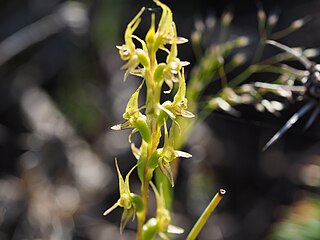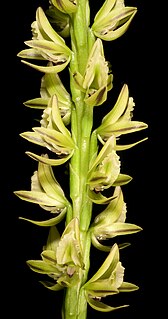
Prasophyllum gracile, commonly known as the little laughing leek orchid, is a species of orchid endemic to the south-west of Western Australia. It is one of the most common and widespread orchids in the south-west and has a single smooth, tube-shaped leaf and up to forty or more, usually yellowish-green flowers.

Prasophyllum petilum, commonly known as the Tarengo leek orchid, is a species of orchid endemic to eastern Australia. It has a single tubular, green leaf and up to eighteen pinkish mauve to greenish flowers, well-spaced along a slender flowering stem. It is a small orchid, difficult to locate, generally growing in taller grasses.
Prasophyllum campestre, commonly known as the sandplain leek orchid, or inland leek orchid, is a species of orchid endemic to eastern Australia. It has a single tubular, yellowish-green leaf and up to twenty greenish, strongly scented flowers with red, purplish, brown or white marks. It grows in the drier parts of Queensland, New South Wales and Victoria.

Prasophyllum brownii, commonly known as the Christmas leek orchid, is a species of orchid endemic to the south-west of Western Australia. It is one of the last of the genus in Western Australia to flower and has a tall flowering stem with up to eighty pale green and fawn-coloured flowers.
Prasophyllum candidum, commonly known as the Kiandra leek orchid, is a species of orchid endemic to eastern Australia. It has a single tubular, yellowish-green leaf and up to forty scented, bright white to greenish flowers. It grows in subalpine areas at altitudes above 1,000 m (3,000 ft) in New South Wales and Victoria although in the latter state it is considered to be a form of P. odoratum.

Prasophyllum colensoi is a species of orchid endemic to New Zealand where it is commonly known as the leek orchid. It has a single tubular, dark green leaf and up to twenty scented, yellowish-green to reddish-brown flowers. It is similar to P. hectori, the only other species of Prasophyllum found in New Zealand, but is distinguished from it by its smaller size, fewer flowers and different habitat.
Prasophyllum cucullatum, commonly known as the hooded leek orchid, is a species of orchid endemic to the south-west of Western Australia. It is a tall orchid with a single smooth, tubular leaf and up to fifty or more purplish-red and white flowers with a frilled labellum crowded along a relatively short flowering stem.

Prasophyllum cyphochilum, commonly known as the pouched leek orchid, is a species of orchid endemic to the south-west of Western Australia. It is a relatively common orchid with a single smooth, tubular leaf and up to thirty or more pale yellow and brown flowers. The flowers do not open fully, are more or less cup-shaped and have a "humped" labellum.
Prasophyllum gibbosum, commonly known as the humped leek orchid, is a species of orchid endemic to the south-west of Western Australia. It is a late-flowering leek orchid with a single smooth, tubular leaf and up to eighty or more purplish-red and white flowers with a smooth labellum. It is similar to P. cucullatum but that species has a frilly labellum, usually a shorter flowering stem and an earlier flowering period.
Prasophyllum gracillimum, commonly known as the slender leek orchid, is a species of orchid endemic to a small region of Western Australia. It has a single tubular green leaf, and green, brown and white flowers loosely arranged along the flowering stem. This species has not been seen for more than fifty years and is considered by some botanists to be a form of P. fimbria.
Prasophyllum laxum, commonly known as the lax leek orchid, is a species of orchid endemic to a small region of South Australia. It has a single tubular leaf and up to twenty pale green, tan and lilac-coloured flowers. It was first collected in the 1960s in a location known as the Hundred of Koppio on the Eyre Peninsula but was not described until 2008 from a new collection in 2004.
Prasophyllum litorale, commonly known as the coastal leek orchid, is a species of orchid endemic to southern continental Australia. It has a single tubular leaf and up to forty flowers with red and green colouring and grows in sandhills near the sea.
Prasophyllum macrostachyum, commonly known as the laughing leek orchid, is a species of orchid endemic to the south-west of Western Australia. It has a single smooth, tube-shaped leaf and up to thirty yellowish-green and purple flowers. It is one of the few Western Australian leek orchids which is not stimulated by summer fires and also has an unusually long flowering period.
Prasophyllum macrotys, commonly known as the inland leek orchid, is a species of orchid endemic to the south-west of Western Australia. It has a single tubular leaf and up to thirty greenish to purplish flowers and is similar to the tall leek orchid but has smaller, darker flowers.
Prasophyllum occultans, commonly known as the hidden leek orchid, is a species of orchid endemic to southern Australia. It has a single, smooth, tube-shaped leaf with a reddish-purple base and up to ten greenish flowers. It is a rare species found only in a few locations in South Australia and in far western Victoria.
Prasophyllum ovale, commonly known as the little leek orchid, is a species of orchid endemic to the south-west of Western Australia. It is a small leek orchid with a single smooth, tubular leaf and up to twenty or more white, green and brown flowers with the labellum only slightly upturned.
Prasophyllum paulinae, commonly known as Pauline's leek orchid, is a species of orchid endemic to the south-west of Western Australia. It is a small, rare leek orchid with a single smooth, tubular leaf and up to seventy yellowish-green and purple flowers.
Prasophyllum plumiforme, commonly known as the dainty leek orchid, is a species of orchid endemic to the south-west of Western Australia. It is a small leek orchid with a single smooth, tubular leaf and up to fifty or more tiny cream-coloured or greenish-yellow flowers on a tall flowering stem.
Prasophyllum roseum, commonly known as the pink lip leek orchid, is a species of orchid endemic to southern continental Australia. It has a single tube-shaped leaf and up to thirty greenish flowers with a pink labellum. It is a recently described plant, previously included with P. fitzgeraldii, but distinguished from that species by its smaller, less crowded flowers, with more spreading lateral sepals and different labellum callus. It grows in the south-east of South Australia and in western Victoria.
Prasophyllum occidentale, commonly known as the plains leek orchid, is a species of orchid endemic to southern continental Australia. It has a single tubular leaf and up to twenty five small, pale yellowish-green flowers. It is found in South Australia and Victoria although regarded by some taxonomists as a South Australian endemic.




